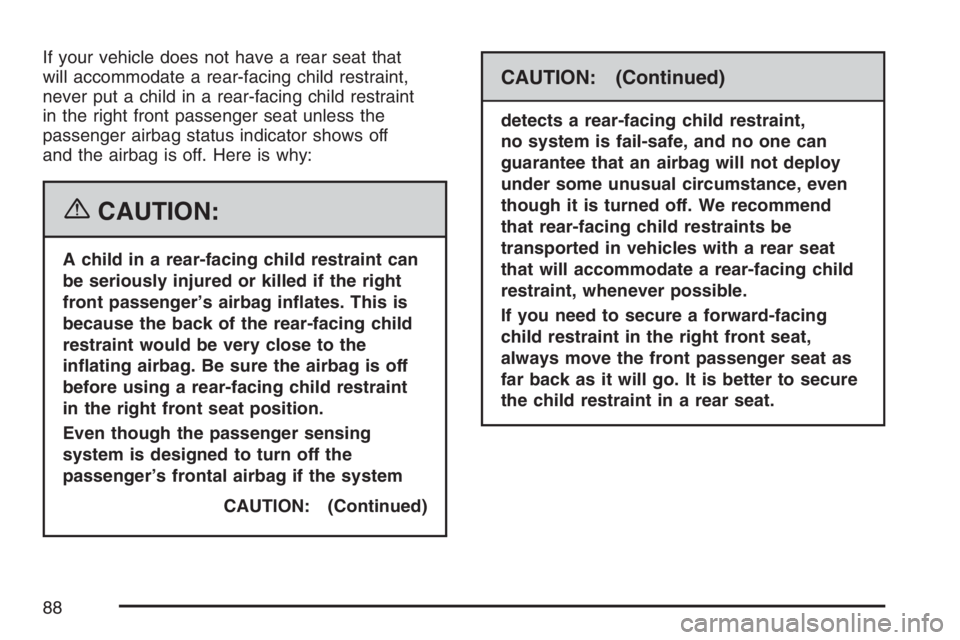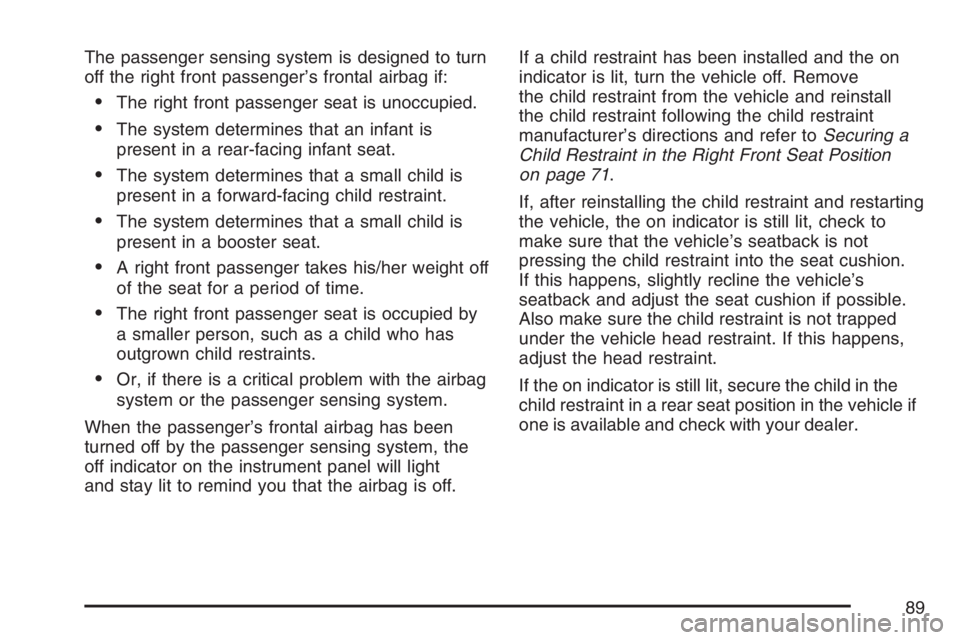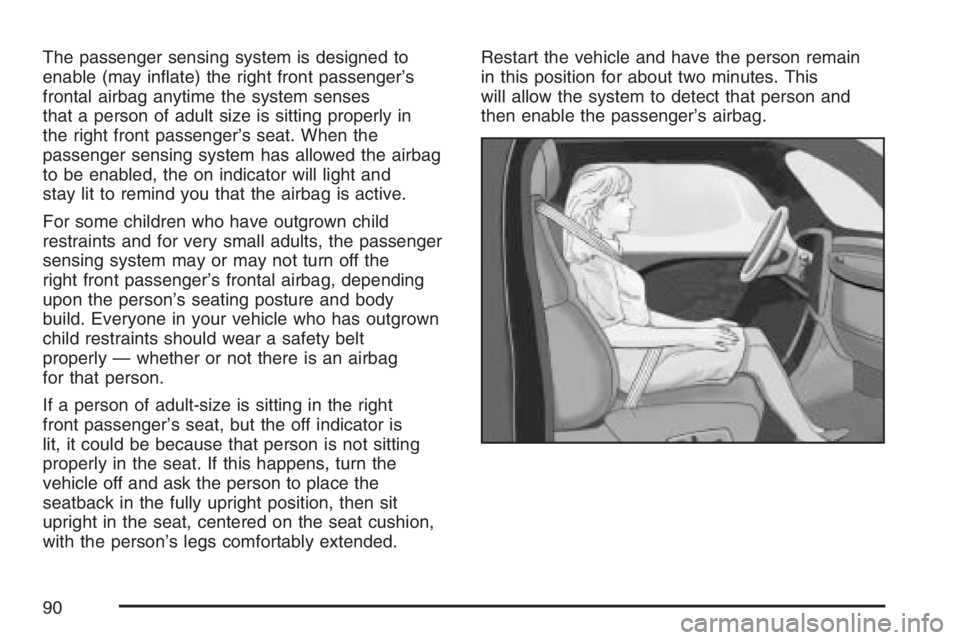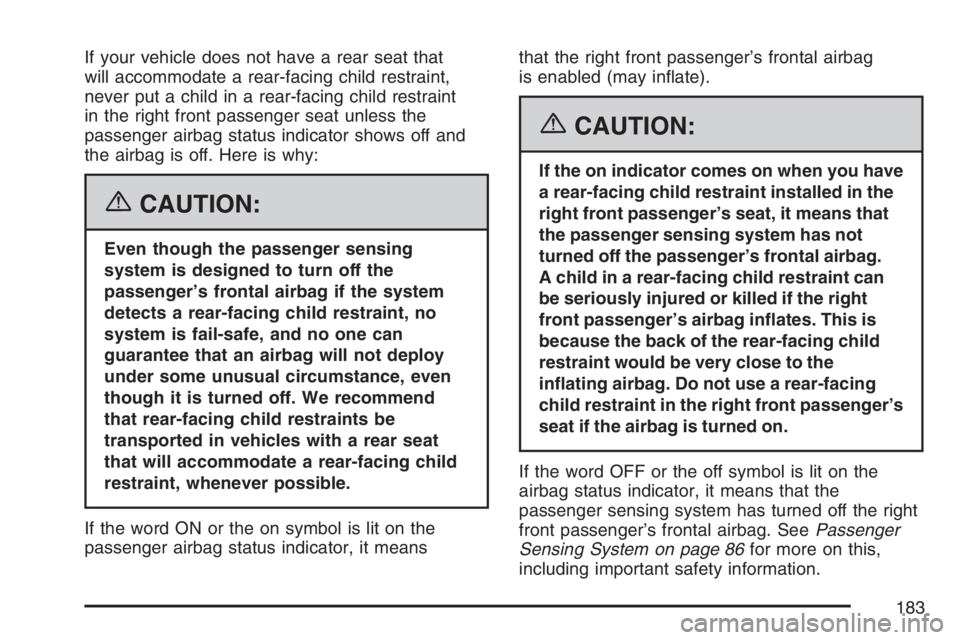2007 GMC CANYON child seat
[x] Cancel search: child seatPage 76 of 492

9. Push and pull the child restraint in different
directions to be sure it is secure.
10. If the airbag is off, the off indicator on the
instrument panel will be lit and stay lit
when the key is turned to ON or START.
If a child restraint has been installed and the on
indicator is lit, turn the vehicle off. Remove the
child restraint from the vehicle and reinstall the
child restraint.
If, after reinstalling the child restraint and restarting
the vehicle, the on indicator is still lit, check to
make sure that the vehicle’s seatback is not
pressing the child restraint into the seat cushion.
If this happens, slightly recline the vehicle’s
seatback and adjust the seat cushion if possible.
Also make sure the child restraint is not trapped
under the vehicle head restraint. If this happens,
adjust the head restraint.
If the on indicator is still lit, secure the child in
the child restraint in a rear seat position in
the vehicle if one is available and check with
your dealer.To remove the child restraint, if the top tether is
attached, disconnect it. Unbuckle the vehicle’s
safety belt and let it go back all the way. The
safety belt will move freely again and be ready
to work for an adult or larger child passenger.
When the safety belt is not in use, slide the latch
plate up the safety belt webbing. The latch
plate should rest on the stitching on the safety
belt, near the upper anchor on the side wall.
Airbag System
Your vehicle has a frontal airbag for the driver
and a frontal airbag for the right front passenger.
Your vehicle may also have roof-mounted side
impact airbags. Roof-mounted side impact airbags
are available for the driver and the passenger
seated directly behind the driver and for the
right front passenger and the passenger seated
directly behind that passenger.
If your vehicle has roof-mounted side impact
airbags, the word AIRBAG will appear on
the airbag covering on the ceiling near the
side windows.
76
Page 87 of 492

The passenger sensing system works with
sensors that are part of the right front passenger’s
seat and safety belt. The sensors are designed
to detect the presence of a properly seated
occupant and determine if the passenger’s frontal
airbag should be enabled (may in�ate) or not.
Accident statistics show that children are safer
if they are restrained in the rear rather than
the front seat. We recommend that child restraints
be secured in a rear seat, including an infant
riding in a rear-facing infant seat, a child riding
in a forward-facing child seat and an older
child riding in a booster seat.
There is a label on your sun visor that says,
“Never put a rear-facing child seat in the front.”
This is because the risk to the rear-facing child
is so great if the airbag deploys.
{CAUTION:
A child in a rear-facing child restraint
can be seriously injured or killed if the
right front passenger’s airbag in�ates.
CAUTION: (Continued)
CAUTION: (Continued)
This is because the back of the
rear-facing child restraint would be very
close to the in�ating airbag.
Even though the passenger sensing
system is designed to turn off the
passenger’s frontal airbag if the system
detects a rear-facing child restraint, no
system is fail-safe, and no one can
guarantee that an airbag will not deploy
under some unusual circumstance, even
though it is turned off. We recommend
that rear-facing child restraints be secured
in the rear seat, even if the airbag is off.
If you need to secure a forward-facing
child restraint in the right front seat,
always move the front passenger seat as
far back as it will go. It is better to secure
the child restraint in a rear seat.
87
Page 88 of 492

If your vehicle does not have a rear seat that
will accommodate a rear-facing child restraint,
never put a child in a rear-facing child restraint
in the right front passenger seat unless the
passenger airbag status indicator shows off
and the airbag is off. Here is why:
{CAUTION:
A child in a rear-facing child restraint can
be seriously injured or killed if the right
front passenger’s airbag in�ates. This is
because the back of the rear-facing child
restraint would be very close to the
in�ating airbag. Be sure the airbag is off
before using a rear-facing child restraint
in the right front seat position.
Even though the passenger sensing
system is designed to turn off the
passenger’s frontal airbag if the system
CAUTION: (Continued)
CAUTION: (Continued)
detects a rear-facing child restraint,
no system is fail-safe, and no one can
guarantee that an airbag will not deploy
under some unusual circumstance, even
though it is turned off. We recommend
that rear-facing child restraints be
transported in vehicles with a rear seat
that will accommodate a rear-facing child
restraint, whenever possible.
If you need to secure a forward-facing
child restraint in the right front seat,
always move the front passenger seat as
far back as it will go. It is better to secure
the child restraint in a rear seat.
88
Page 89 of 492

The passenger sensing system is designed to turn
off the right front passenger’s frontal airbag if:
The right front passenger seat is unoccupied.
The system determines that an infant is
present in a rear-facing infant seat.
The system determines that a small child is
present in a forward-facing child restraint.
The system determines that a small child is
present in a booster seat.
A right front passenger takes his/her weight off
of the seat for a period of time.
The right front passenger seat is occupied by
a smaller person, such as a child who has
outgrown child restraints.
Or, if there is a critical problem with the airbag
system or the passenger sensing system.
When the passenger’s frontal airbag has been
turned off by the passenger sensing system, the
off indicator on the instrument panel will light
and stay lit to remind you that the airbag is off.If a child restraint has been installed and the on
indicator is lit, turn the vehicle off. Remove
the child restraint from the vehicle and reinstall
the child restraint following the child restraint
manufacturer’s directions and refer toSecuring a
Child Restraint in the Right Front Seat Position
on page 71.
If, after reinstalling the child restraint and restarting
the vehicle, the on indicator is still lit, check to
make sure that the vehicle’s seatback is not
pressing the child restraint into the seat cushion.
If this happens, slightly recline the vehicle’s
seatback and adjust the seat cushion if possible.
Also make sure the child restraint is not trapped
under the vehicle head restraint. If this happens,
adjust the head restraint.
If the on indicator is still lit, secure the child in the
child restraint in a rear seat position in the vehicle if
one is available and check with your dealer.
89
Page 90 of 492

The passenger sensing system is designed to
enable (may in�ate) the right front passenger’s
frontal airbag anytime the system senses
that a person of adult size is sitting properly in
the right front passenger’s seat. When the
passenger sensing system has allowed the airbag
to be enabled, the on indicator will light and
stay lit to remind you that the airbag is active.
For some children who have outgrown child
restraints and for very small adults, the passenger
sensing system may or may not turn off the
right front passenger’s frontal airbag, depending
upon the person’s seating posture and body
build. Everyone in your vehicle who has outgrown
child restraints should wear a safety belt
properly — whether or not there is an airbag
for that person.
If a person of adult-size is sitting in the right
front passenger’s seat, but the off indicator is
lit, it could be because that person is not sitting
properly in the seat. If this happens, turn the
vehicle off and ask the person to place the
seatback in the fully upright position, then sit
upright in the seat, centered on the seat cushion,
with the person’s legs comfortably extended.Restart the vehicle and have the person remain
in this position for about two minutes. This
will allow the system to detect that person and
then enable the passenger’s airbag.
90
Page 182 of 492

Passenger Airbag Status Indicator
Your vehicle has the passenger sensing system.
Your instrument panel has a passenger airbag
status indicator.
When the ignition key is turned to ON or START,
the passenger airbag status indicator will light
ON and OFF, or the symbol for on and off,
for several seconds as a system check. Then,
after several more seconds, the status indicator
will light either ON or OFF, or either the on
or off symbol to let you know the status of the
right front passenger’s frontal airbag.There is a label on your sun visor that says,
“Never put a rear-facing child seat in the front.”
This is because the risk to the rear-facing child is
so great if the airbag deploys.
{CAUTION:
Even though the passenger sensing
system is designed to turn off the
passenger’s frontal airbag if the system
detects a rear-facing child restraint, no
system is fail-safe, and no one can
guarantee that an airbag will not deploy
under some unusual circumstance, even
though it is turned off. We recommend
that rear-facing child restraints be secured
in the rear seat, even if the airbag is off.
United StatesCanada
182
Page 183 of 492

If your vehicle does not have a rear seat that
will accommodate a rear-facing child restraint,
never put a child in a rear-facing child restraint
in the right front passenger seat unless the
passenger airbag status indicator shows off and
the airbag is off. Here is why:
{CAUTION:
Even though the passenger sensing
system is designed to turn off the
passenger’s frontal airbag if the system
detects a rear-facing child restraint, no
system is fail-safe, and no one can
guarantee that an airbag will not deploy
under some unusual circumstance, even
though it is turned off. We recommend
that rear-facing child restraints be
transported in vehicles with a rear seat
that will accommodate a rear-facing child
restraint, whenever possible.
If the word ON or the on symbol is lit on the
passenger airbag status indicator, it meansthat the right front passenger’s frontal airbag
is enabled (may in�ate).
{CAUTION:
If the on indicator comes on when you have
a rear-facing child restraint installed in the
right front passenger’s seat, it means that
the passenger sensing system has not
turned off the passenger’s frontal airbag.
A child in a rear-facing child restraint can
be seriously injured or killed if the right
front passenger’s airbag in�ates. This is
because the back of the rear-facing child
restraint would be very close to the
in�ating airbag. Do not use a rear-facing
child restraint in the right front passenger’s
seat if the airbag is turned on.
If the word OFF or the off symbol is lit on the
airbag status indicator, it means that the
passenger sensing system has turned off the right
front passenger’s frontal airbag. SeePassenger
Sensing System on page 86for more on this,
including important safety information.
183
Page 291 of 492

{CAUTION:
Things you put inside your vehicle can
strike and injure people in a sudden stop
or turn, or in a crash.
Put things in the cargo area of your
vehicle. Try to spread the weight
evenly.
Never stack heavier things, like
suitcases, inside the vehicle so that
some of them are above the tops of
the seats.
Do not leave an unsecured child
restraint in your vehicle.
When you carry something inside the
vehicle, secure it whenever you can.
Do not leave a seat folded down
unless you need to.
There is also important loading information for
off-road driving in this manual. See“Loading Your
Vehicle for Off-Road Driving”underOff-Road
Driving on page 256.
Remember not to exceed the Gross Axle Weight
rating (GAWR) of the front or rear axle.
Two-Tiered Loading
By positioning four 2” X 6” wooden planks across
the width of the pickup box, you can create an
upper load platform. The planks must be inserted
in the pickup box depressions. The length of
the planks must allow for at least a 3/4 inch (2 cm)
bearing surface on each end of the plank.
When using this upper load platform, be sure the
load is securely tied down to prevent it from
shifting. The load’s center of gravity should be
positioned in a zone over the rear axle.
Any load that extends beyond the vehicle’s
taillamp area must be properly marked according
to local laws and regulations.
Remember not to exceed the Gross Axle Weight
Rating (GAWR) of the rear axle.
291